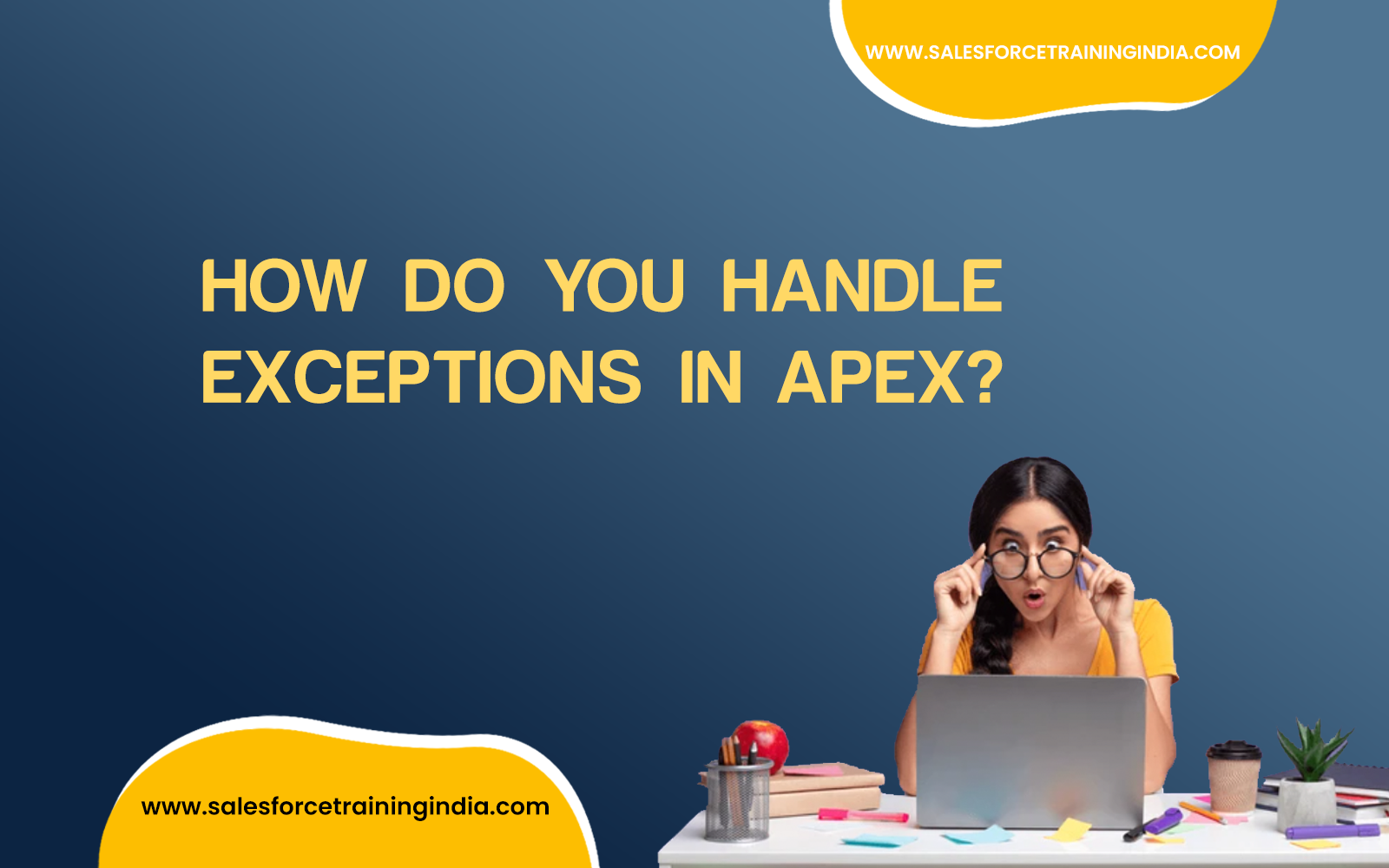Exception handling in Apex is similar to Java and other programming languages. It involves the use of try, catch, and finally blocks. In a try block, you write the code that might throw an exception. The catch block is used to catch and handle the exception, allowing you to log errors or take corrective actions. The finally block is optional and is executed regardless of whether an exception is caught or not, typically used for cleaning up resources like closing files. Apex provides a set of standard exceptions (like DmlException, QueryException) and also allows you to define custom exceptions.
How to handle the exception in Apex?
To handle exceptions in Apex, use try-catch blocks. Enclose the code that might throw an exception within a try block and handle the exception in the catch block. Optionally, you can include a finally block to execute code regardless of whether an exception occurs. This approach allows you to gracefully manage errors and ensure your application continues running smoothly.
What happens when an apex exception occurs?
When an Apex exception occurs, the normal flow of execution is interrupted, and the code jumps to the nearest catch block that can handle the specific type of exception. If no appropriate catch block is found, the exception propagates up the call stack, potentially causing the transaction to fail and rolling back any database changes made during the transaction.
How do you handle all exceptions?
To handle all exceptions, you can use a generic catch block that catches the base Exception class. This approach ensures that any exception, regardless of its specific type, is caught and handled. However, it is best practice to catch and handle specific exceptions when possible, providing more precise error handling and debugging information.
How to handle exceptions in batch apex?
In Batch Apex, exceptions can be handled in the execute method using try-catch blocks. Additionally, you can implement the Database.RaisesPlatformEvents interface to capture and respond to platform events triggered by exceptions. Handling exceptions in Batch Apex ensures that individual failures do not disrupt the entire batch processing.
How do I test exceptions in Apex?
To test exceptions in Apex, use test methods that deliberately cause the conditions under which the exceptions should be thrown. Use System.assertException or try-catch blocks within test methods to verify that the exceptions are thrown as expected and handled correctly.
Which exception type Cannot be caught in Apex?
The LimitException type cannot be caught in Apex. This exception occurs when a governor limit is exceeded, and it is designed to prevent resource exhaustion. When a LimitException is thrown, it cannot be handled or caught, and the transaction is immediately halted.
What are the 2 ways I can handle exception?
The two ways to handle exceptions in Apex are:
- Try-catch blocks: Enclose code that might throw an exception within a try block and handle the exception in the catch block.
- Using declarative tools: In some cases, you can configure error handling through Salesforce’s declarative tools, such as setting up fault paths in Flow Builder.
What are the rules for handling exceptions successfully?
Successfully handling exceptions involves:
- Catching specific exceptions: Handle known exceptions with specific catch blocks.
- Logging exceptions: Record details of the exceptions for debugging and monitoring purposes.
- Graceful degradation: Ensure the application continues running or fails gracefully without disrupting the user experience.
- Providing feedback: Inform users of the error and possible corrective actions.
- Rolling back transactions: Ensure data integrity by rolling back database changes when necessary.
How do you solve exceptions?
Solving exceptions involves:
- Identifying the cause: Use debug logs and exception messages to pinpoint the source of the error.
- Implementing try-catch blocks: Add appropriate error handling to catch and manage exceptions.
- Fixing logic errors: Correct any logic issues or bugs in the code causing the exceptions.
- Testing thoroughly: Test the code to ensure exceptions are handled and the application behaves as expected under different scenarios.
How to handle list has no rows for assignment to SObject?
To handle the “List has no rows for assignment to SObject” exception, check if the query returns any rows before assigning it to an SObject. Use a try-catch block or an if statement to ensure that the list is not empty before accessing its elements.
How do I overcome null pointer exception in Apex?
To overcome a null pointer exception in Apex, always check for null values before accessing object properties or methods. Use conditional statements to verify that an object is not null before performing operations on it. Additionally, initializing variables properly can help prevent null pointer exceptions.
How do you cover catch exceptions in Apex class?
To cover catch exceptions in an Apex class, include test methods that simulate conditions leading to exceptions. Use assertions to verify that the exceptions are caught and handled correctly. Ensure your tests cover various scenarios to validate the robustness of your exception handling.
What are exceptions in Salesforce?
Exceptions in Salesforce are unexpected events or errors that occur during the execution of Apex code. These can result from logic errors, data issues, or system limitations. Salesforce provides a range of exception types, such as DmlException, QueryException, and NullPointerException, each indicating a specific error condition that must be managed through proper error handling techniques.
How do I handle exceptions in trigger in Salesforce?
To handle exceptions in a Salesforce trigger, wrap the trigger logic in try-catch blocks. This ensures that any errors occurring during trigger execution are caught and managed, preventing the transaction from failing. Log the exception details and provide meaningful error messages to aid in debugging and user notification.
How do I fix apex errors?
To fix Apex errors, follow these steps:
- Identify the error: Use debug logs and exception messages to locate the source of the error.
- Analyze the cause: Determine whether the error is due to logic issues, data problems, or system limitations.
- Correct the code: Implement the necessary fixes to address the root cause of the error.
- Test thoroughly: Validate the changes through comprehensive testing to ensure the error is resolved and no new issues are introduced.
Are you eager to excel in Salesforce? Look no further than our specialized Salesforce training in Hyderabad. We offer a comprehensive, project-based course that immerses you in real-time scenarios and equips you with practical skills and up-to-date knowledge. With a strong focus on daily notes, hands-on projects, and meticulous preparation for certification exams and interviews, our training ensures you’re fully prepared for the diverse challenges of the Salesforce industry.
Don’t delay in advancing your career. Enroll today in our Salesforce online course and benefit from personalized mentorship from seasoned instructors. Whether you’re starting from scratch or looking to deepen your expertise, our tailored program in Hyderabad is designed to empower your success. Take the initiative to elevate your professional journey with us.





